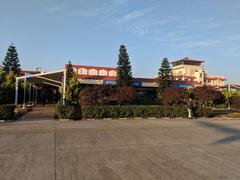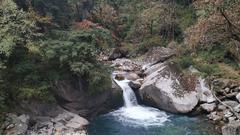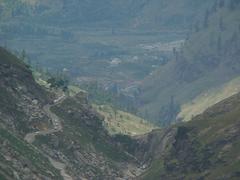National Highway 305 Himachal Pradesh Visiting Guide: Tickets, Travel Tips, and Essential Information
Date: 14/06/2025
Introduction
National Highway 305 (NH 305) in Himachal Pradesh is one of India’s most scenic mountain highways, offering travelers a journey through the heart of the Himalayas. Spanning approximately 97 kilometers, NH 305 connects Aut in the Kullu Valley to Luhri near Shimla, passing through the breathtaking Banjar Valley and traversing the iconic Jalori Pass. Along the way, visitors encounter dense deodar forests, alpine meadows, pristine rivers, and vibrant Himachali culture.
Declared a National Highway in 2012, NH 305 plays a vital role in enhancing connectivity between Kullu and Shimla, supporting tourism, and improving local economies. Whether you’re an adventure enthusiast, a cultural explorer, or a seeker of tranquility, NH 305 promises a memorable and diverse Himalayan experience.
For up-to-date travel details, consult the Himachal Tourism Official Website and the Great Himalayan National Park site.
Table of Contents
- Historical Background of NH 305
- Route Overview and Highlights
- Travel Tips and Road Conditions
- Nearby Attractions and Cultural Highlights
- Socio-Economic and Environmental Impact
- Challenges and Maintenance Efforts
- Visiting Hours and Ticket Information
- Historical Sites and Cultural Highlights
- Wildlife and Nature
- Environmental and Cultural Insights
- Frequently Asked Questions (FAQ)
- Conclusion and Recommendations
- References
Historical Background of NH 305
Originally a state road primarily serving the Seraj Valley, NH 305 was elevated to National Highway status in 2012 to improve connectivity across Himachal Pradesh’s challenging terrain. This upgrade has opened up remote regions, stimulated tourism, and facilitated economic growth by linking Kullu and Shimla districts (Holidify).
Route Overview and Highlights
Geographic Span and Connectivity
NH 305 branches from NH 5 at Sainj and rejoins NH 3 at Aut. It serves as a strategic alternative between Shimla and Kullu-Manali, particularly useful when main highways are affected by landslides or snowfall.
Key Route Segments:
- Sainj to Luhri: This stretch passes through apple orchards and the traditional town of Luhri.
- Luhri to Ani: The road ascends through pine and deodar forests, offering views of the Sutlej River, and leads to Ani, a popular rest stop.
- Ani to Jalori Pass: A challenging ascent to the 3,220-meter (10,800 ft) Jalori Pass, one of the region’s highest motorable points.
- Jalori Pass to Shoja and Jibhi: Descending through villages known for their wooden architecture and peaceful ambiance.
- Jibhi to Banjar and Aut: The final leg follows the Tirthan River, ending at Aut, and provides access to eco-tourism hotspots.
Scenic and Geographic Highlights:
Travelers are rewarded with dramatic Himalayan landscapes, dense forests, meandering rivers, and panoramic valley views. The road’s sharp bends and narrow stretches make it a favorite for adventure seekers.
Travel Tips and Road Conditions
Best Time to Travel
- Optimal Season: Late April to early November, when Jalori Pass is snow-free and roads are safer.
- Seasonal Closures: Jalori Pass is generally closed from December to March due to heavy snowfall.
Road Conditions and Safety
- Road Quality: Single-lane, narrow, and winding. Drive with caution, especially near Jalori Pass and during the monsoon (July–September) when landslides are common.
- Vehicle Recommendation: Four-wheel-drive vehicles are preferable; ensure your vehicle is well-maintained.
- Fuel and Supplies: Fuel stations are available at Sainj, Ani, and Banjar. ATMs are limited; carry cash.
Accessibility
- Public Transport: Limited. Shared taxis and private vehicles are the main options.
- Mobile Connectivity: Patchy near Jalori Pass; inform someone of your itinerary.
Travel Preparation
- Acclimatize for high-altitude travel.
- Carry warm clothing, rain gear, and emergency supplies.
- Check local weather and road conditions before departure.
Nearby Attractions and Cultural Highlights
- Jalori Pass: A trekking hub with access to Serolsar Lake; offers panoramic Himalayan views.
- Banjar and Jibhi: Eco-tourism destinations with charming homestays, proximity to the Great Himalayan National Park, and opportunities for trout fishing.
- Shoja: Known for tranquil settings and mountain vistas.
- Seraj Valley Villages: Renowned for traditional Himachali wooden temples, vibrant festivals, and Kathkuni architecture.
Socio-Economic and Environmental Impact
The development of NH 305 has improved access to healthcare, education, and markets for remote villages and has fueled tourism-driven economic growth. However, increased traffic and tourist inflow have also brought concerns over environmental degradation and cultural preservation. Sustainable tourism practices and infrastructure management are imperative to protect this fragile region.
Challenges and Maintenance Efforts
NH 305 regularly faces challenges such as landslides, erosion, and road wear—especially between Aut and Ghiyagi. Maintenance is ongoing but often temporary. Strategic proposals like tunneling under Jalori Pass are under consideration but face logistical and environmental hurdles. Local committees advocate for widening, improved surfacing, and better safety barriers.
Visiting Hours and Ticket Information
Jalori Pass
- Hours: Open 7:00 AM to 6:00 PM, late April to early November; closed in winter.
- Tickets: No entry fee for the pass itself.
Great Himalayan National Park (GHNP)
- Hours: 8:00 AM to 5:00 PM daily.
- Tickets: Entry permit required; available at park gates or online. Fees differ for Indian and foreign tourists.
Temples and Heritage Sites
- Shringa Rishi Temple (Baggi): Open 6:00 AM–8:00 PM; free entry.
- Chehni Kothi: Open year-round; no ticket required, but visitors should respect local customs.
Historical Sites and Cultural Highlights
- Chehni Kothi: A stunning example of traditional Kathkuni-style architecture—a multi-storey stone-and-wood fortress and granary.
- Shringa Rishi and Bagi Temples: Centers of local devotion and culture; venues for vibrant regional festivals.
- Naggar Castle and Bijli Mahadev: Accessible via short detours, offering insights into Himachal’s history and spirituality (Lonely Planet).
Wildlife and Nature
NH 305 skirts the Great Himalayan National Park, home to Himalayan tahr, musk deer, black bears, and over 3,200 plant species. The forests of deodar, pine, oak, and rhododendron are especially vibrant in spring and autumn (Tusk Travel).
Environmental and Cultural Insights
The region is home to Kullvi, Sainji, and Seraji communities, whose traditional practices help maintain ecological balance. Ancient temples and festivals such as Fagli and Phagli underscore the deep connection between people and nature. Conservation efforts focus on protecting habitats and promoting responsible tourism.
Frequently Asked Questions (FAQ)
Q1: Is NH 305 open year-round?
A1: No, Jalori Pass is closed December to March due to snowfall.
Q2: Are there tolls or tickets for NH 305?
A2: The highway itself is toll-free; however, permits are required for certain protected areas like GHNP.
Q3: What vehicle is best for NH 305?
A3: A four-wheel-drive vehicle is recommended, especially during monsoon or periods of poor road conditions.
Q4: Is public transport available?
A4: Limited; shared taxis and private vehicles are most common.
Q5: What are the must-see attractions?
A5: Jalori Pass, Serolsar Lake, Banjar, Jibhi, Chehni Kothi, and Great Himalayan National Park.
Conclusion and Recommendations
NH 305 stands out as a gateway to Himachal Pradesh’s scenic splendor and cultural richness. From the adventure of Jalori Pass to tranquil villages and the sacred Shrikhand Mahadev Temple, the highway offers something for every traveler. Plan your journey between late April and early November, prepare thoroughly, and respect local customs and the fragile environment.
Embrace sustainable tourism to help preserve this unique region. Use resources like the Himachal Tourism Official Website and travel guides for reliable information. For real-time updates, detailed guides, and exclusive offers, download the Audiala app and follow Audiala on social media.
Safe travels as you discover the unforgettable charm of NH 305 and the Himalayas!
References
- Himachal Tourism Official Website
- Holidify
- Great Himalayan National Park
- Lonely Planet – Naggar Castle
- Tusk Travel – Best Places in Himachal Pradesh
- Kullu District Administration



